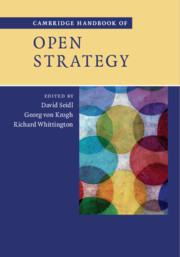Book contents
- Cambridge Handbook of Open Strategy
- Cambridge Handbook of Open Strategy
- Copyright page
- Contents
- Figures
- Tables
- Introduction
- Part I The Concept of Open Strategy
- Part II Practices of Open Strategy
- Part III Technological Assemblages for Open Strategy
- Part IV Theoretical Perspectives
- Chapter 13 Practice-Theoretical Perspectives on Open Strategy: Implications of a Strong Programme
- Chapter 14 A Sensemaking Perspective on Open Strategy
- Chapter 15 A Dialogic Perspective on Open Strategy
- Chapter 16 A Social Network Perspective on Open Strategy
- Chapter 17 An Institutional Perspective on Open Strategy: Strategy in World Society
- Part V Challenges of Open Strategy
- Index
- References
Chapter 14 - A Sensemaking Perspective on Open Strategy
from Part IV - Theoretical Perspectives
Published online by Cambridge University Press: 13 July 2019
- Cambridge Handbook of Open Strategy
- Cambridge Handbook of Open Strategy
- Copyright page
- Contents
- Figures
- Tables
- Introduction
- Part I The Concept of Open Strategy
- Part II Practices of Open Strategy
- Part III Technological Assemblages for Open Strategy
- Part IV Theoretical Perspectives
- Chapter 13 Practice-Theoretical Perspectives on Open Strategy: Implications of a Strong Programme
- Chapter 14 A Sensemaking Perspective on Open Strategy
- Chapter 15 A Dialogic Perspective on Open Strategy
- Chapter 16 A Social Network Perspective on Open Strategy
- Chapter 17 An Institutional Perspective on Open Strategy: Strategy in World Society
- Part V Challenges of Open Strategy
- Index
- References
Summary
Open Strategy, both as a set of processes and practices, and as an emerging academic field, “promises increased transparency and inclusion regarding strategic issues, engaging both internal and external stakeholders” (Hautz et al., 2017: 298; see also Whittington et al., 2011). Open contexts, by involving greater transparency and inclusiveness, strongly impact the way multiple stakeholders make sense of strategy or, in other words, negotiate, disseminate, or even contest the issues at play in strategic change. The diversity that openness brings to the strategic table – a diversity of people (inclusion) but also of information and of perspectives (transparency) – offers organizations more possibilities to help them to make sense of their complex environment (Seidl & Werle, 2018). To uphold the dual promise of inclusion and transparency, Open Strategy would therefore benefit from sensemaking research’s attention to the detailed practices through which people form a shared understanding.
Information
- Type
- Chapter
- Information
- Cambridge Handbook of Open Strategy , pp. 241 - 258Publisher: Cambridge University PressPrint publication year: 2019
References
Accessibility standard: Unknown
Why this information is here
This section outlines the accessibility features of this content - including support for screen readers, full keyboard navigation and high-contrast display options. This may not be relevant for you.Accessibility Information
- 5
- Cited by
